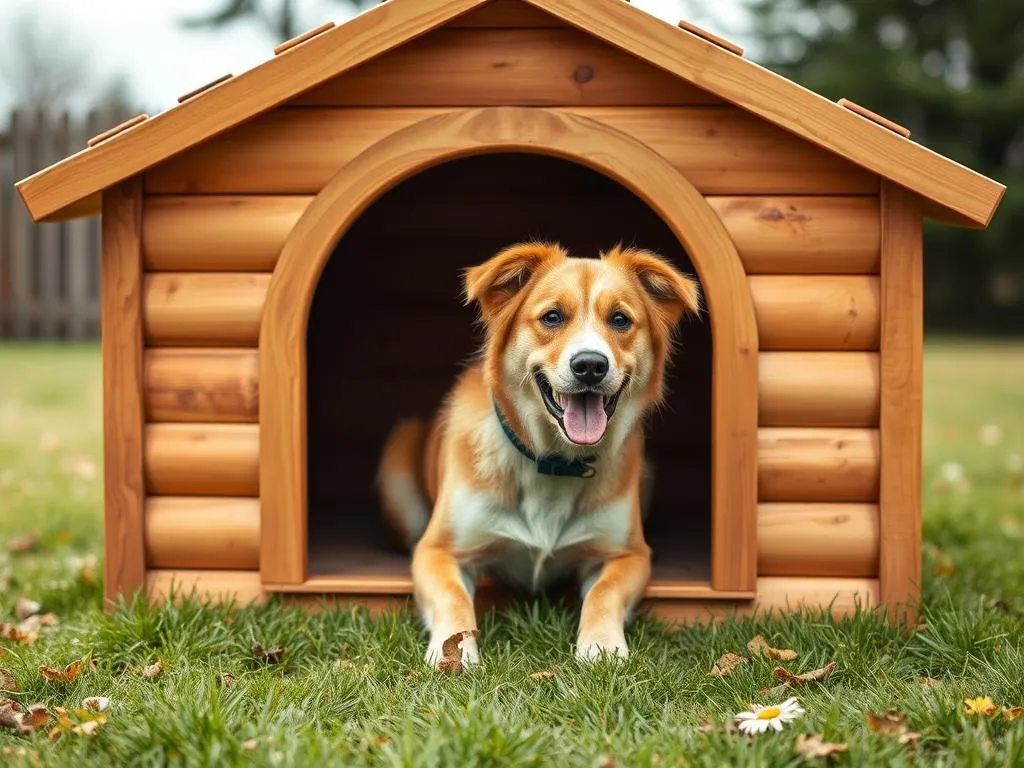
Introduction
Dog houses are more than just a place for your furry friend to rest; they provide shelter and comfort, acting as a safe haven for dogs. Training your dog to use a dog house is not only beneficial for their safety but also promotes independence and comfort. A well-trained dog can enjoy their personal space, especially during inclement weather or when they need a break from social interactions. This guide focuses on effective methods for training your dog to use a dog house, ensuring a smooth transition for both you and your pet.
Understanding Your Dog’s Natural Instincts
Canine Behavior Basics
Dogs are instinctively den animals, seeking small, enclosed spaces that offer security and warmth. This natural behavior is rooted in their ancestry, where wild canines would find refuge in dens to protect themselves from predators and harsh elements. Recognizing this instinct is crucial when training your dog to use a dog house, as it aligns with their inherent needs.
Recognizing Your Dog’s Comfort Zones
Each dog has its unique personality and preferences, which can influence how they react to a dog house. Look for signs that indicate your dog feels secure, such as:
- Relaxed body posture
- Wagging tail
- Willingly entering smaller spaces
Understanding your dog’s comfort zones will guide you in creating a space that they find inviting and safe.
Choosing the Right Dog House
Size and Space Considerations
Selecting the appropriate size dog house is vital. A dog house should be large enough for your dog to stand, turn around, and lie down comfortably but not so large that it loses its cozy feel. Here are some general guidelines:
- Small Breeds: 24” x 18” x 18”
- Medium Breeds: 30” x 24” x 24”
- Large Breeds: 36” x 28” x 28”
Environmental Factors
The location of the dog house is equally important. Consider the following:
- Shade and Sun Exposure: Place the dog house in a shaded area to keep it cool during summer and protect it from harsh sunlight.
- Wind Protection: Ensure the house is shielded from strong winds, which can make your dog uncomfortable.
Design and Materials
Dog houses come in various designs and materials. Common options include:
- Wood: Durable and provides good insulation. Ensure it’s treated to resist rot.
- Plastic: Lightweight and easy to clean, but may not offer as much insulation.
- Insulated: Ideal for extreme weather conditions, keeping your dog warm in winter and cool in summer.
Opt for materials that prioritize durability and safety. Avoid houses with sharp edges or toxic finishes.
Preparing the Dog House
Making It Inviting
To encourage your dog to use their new home, make the dog house inviting:
- Bedding: Add soft bedding or blankets to create a comfortable resting place.
- Toys: Include familiar toys that carry your scent, helping your dog feel more at ease.
- Familiar Scents: You can rub a worn t-shirt or blanket inside the house to give your dog a sense of familiarity.
Ensuring Safety
Before introducing your dog to the dog house, conduct a safety check:
- Sharp Edges: Inspect for any sharp edges that could harm your dog.
- Toxic Materials: Ensure that no harmful chemicals or materials are present.
- Accessibility: Make sure the entrance is easy for your dog to navigate, especially for older dogs or puppies.
Positioning the Dog House
Choose the right spot for the dog house in your yard or home. Ideally, it should be placed:
- On level ground to prevent water accumulation.
- Near your home, so your dog feels connected to you while having their own space.
Training Techniques to Encourage Use
Positive Reinforcement
One of the most effective training methods is positive reinforcement. This involves rewarding your dog for desired behaviors. When training your dog to use the dog house:
- Treats: Offer treats when your dog enters or explores the dog house.
- Praise: Use verbal praise and affectionate pets to reinforce positive behavior.
- Playtime: Engage your dog in playtime near the dog house, gradually encouraging them to enter it.
Gradual Introduction
Start with short, controlled sessions to help your dog become comfortable with the dog house:
- Familiarization: Allow your dog to sniff and explore the dog house without pressure.
- Encouragement: Use treats to lure your dog inside, rewarding them immediately when they enter.
- Short Sessions: Keep initial sessions brief, gradually increasing the time your dog spends inside.
Creating a Routine
Establishing a consistent routine can significantly aid in training:
- Feeding Times: Encourage your dog to eat in the dog house, associating it with positive experiences.
- Naptime: Create a designated naptime in the dog house, reinforcing it as a cozy resting spot.
- Regular Check-ins: Spend time near the dog house, making it a natural part of your dog’s environment.
Troubleshooting Common Issues
Fear or Reluctance to Enter
If your dog shows fear or reluctance to enter the dog house, it’s essential to address their anxiety:
- Signs of Anxiety: Look for signs like whimpering, barking, or backing away from the house.
- Desensitization Techniques: Gradually expose your dog to the house, rewarding them for approaching it and building confidence over time.
Refusing to Stay Inside
If your dog enters the house but refuses to stay inside, consider the following:
- Comfort Improvements: Make the space more appealing by adding additional bedding or toys.
- Positive Reinforcement: Continue rewarding your dog for staying inside, gradually increasing the duration.
Outside Distractions
Outside distractions can deter your dog from using their house. To mitigate this:
- Identify Distractions: Observe what distracts your dog (e.g., other animals, noises).
- Create Barriers: If possible, create a barrier to minimize distractions, ensuring they feel secure in their space.
Monitoring Progress
Tracking Behavior Changes
Keep a log of your dog’s interactions with the dog house to monitor progress:
- Frequency of Use: Note how often your dog enters and stays in the house.
- Behavior Changes: Record any changes in behavior, such as increased comfort or reluctance.
Adjusting Training Methods
Be prepared to adapt your approach based on your dog’s progress:
- Modify Techniques: If your dog is not responding to a particular method, try different rewards or training techniques.
- Seek Professional Help: If challenges persist, consider consulting a professional trainer for personalized guidance.
Celebrating Milestones
Recognizing and celebrating milestones can motivate both you and your dog:
- Small Victories: Celebrate when your dog enters the house willingly or stays inside for an extended period.
- Positive Reinforcement: Continue reinforcing positive behaviors with treats, praise, and affection.
Conclusion
Training your dog to use a dog house is a rewarding journey that enhances their comfort and security. By understanding your dog’s instincts, choosing the right house, and implementing effective training techniques, you can create a positive experience for your pet. Remember to be patient and consistent; each dog learns at their own pace. The long-term benefits of a well-trained dog that enjoys their own space are invaluable both for you and your furry friend.
Incorporating these strategies will not only provide shelter and comfort for your dog but also foster a deeper bond between you and your beloved pet. With a little time and effort, you’ll find that your dog will happily embrace their new dog house as their personal retreat.









